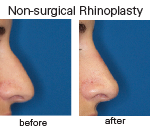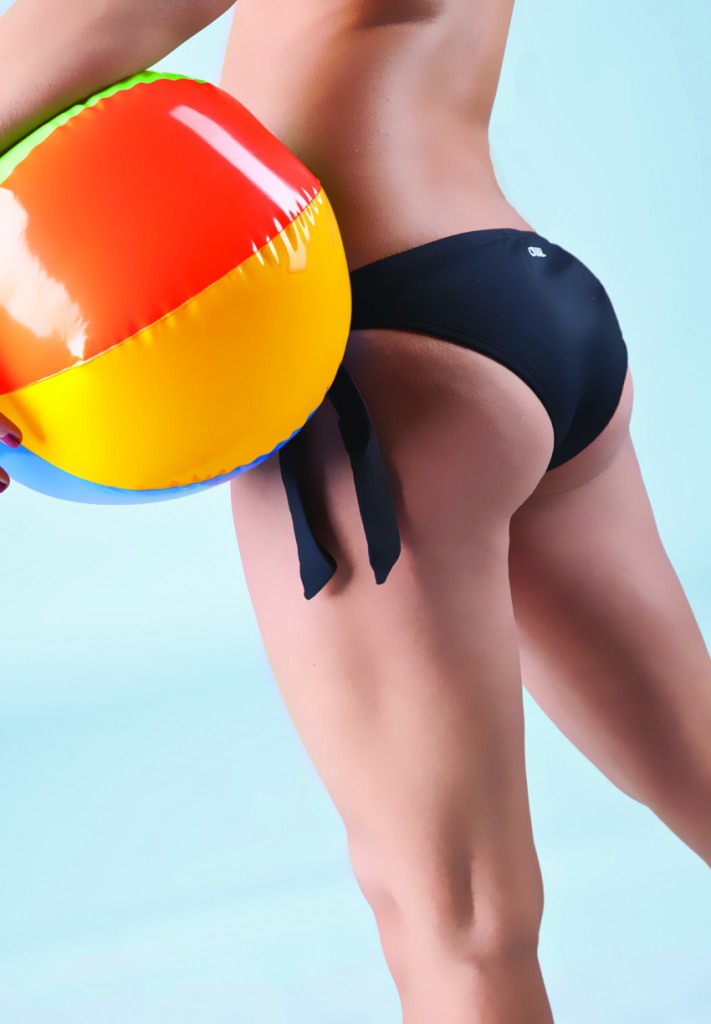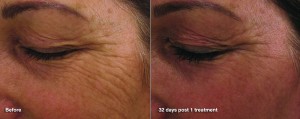Enhancing Features, Enhancing Lives
Rhinoplasty: Dramatic Yet Natural
Rhinoplasty is the most complex of the common plastic surgery procedures. Contemporary techniques achieve a delicate balance between obtaining dramatic results and maintaining a natural appearance. Nasal breathing problems are also addressed, so that patients can look and breathe better. New non-surgical techniques utilize injectable fillers to enhance the nasal appearance without surgery in select patients.
Rhinoplasty may be performed for cosmetic or medical reasons. Medical procedures involve correcting the nasal bones and cartilage when they obstruct breathing. Such corrections may involve straightening deviation of the nasal bones, strengthening areas of weak cartilage, or opening blockages. Rhinoplasty may be combined with septoplasty, a procedure that alleviates obstruction inside the nose caused by irregularities in the nasal septum (the thin wall of bone and cartilage that divides the right and left sides of the nasal cavity). Insurance may cover rhinoplasty and septoplasty performed to improve breathing.
Cosmetic rhinoplasty must be individualized to suit each patient’s personal esthetic goals and physical characteristics. The goal is generally to achieve a dramatic but natural change. The procedure can be more or less aggressive depending on the patient’s goals while maintaining familial and ethnic traits to maintain balance with the whole face. Common goals include reducing a hump on the bridge of the nose, decreasing the overall size of the nose, straightening deviation, elevating the tip of the nose, and making the nostrils smaller.
Two basic rhinoplasty techniques exist: open and closed (also known as endonasal). Some surgeons use only one technique, but in general open rhinoplasty is used for more aggressive procedures and procedures requiring refinement of the nasal tip. Closed rhinoplasty may be more commonly used for surgery being performed just to improve breathing or when reducing a hump of the nasal bridge without other esthetic changes.
The most significant recent development in the field of rhinoplasty is the non-surgical rhinoplasty, in which injectable fillers, like Radiesse™ and Restylane™, are used to enhance the nasal appearance. Asymmetries and irregularities may be smoothed out. A small hump in the bridge may be minimized, and the nasal tip can be elevated. Non-surgical rhinoplasty is performed in the office, with no anesthesia, like most cosmetic injections. The injectable fillers are not permanent, so the achieved changes are not either, but they generally last for several months.
Prospective rhinoplasty patients need to be sure they find a surgeon who is a board certified plastic surgeon with a special interest in rhinoplasty; the surgeon should have extensive experience with the procedure. Please visit www.drgoldman.com for more information.
Traditional Rhinoplasty
before After
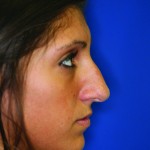
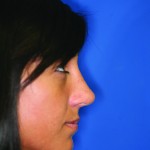
Brazilian Style Butt Lift
Mark A. Foglietti, D.O.
Derriere, fanny, posterior, rear, rump, buttocks, bum, the list goes on; for as many names that this body part has, there are an equal number of differences in their shapes. There are voluptuous curves like those of Sofia Vergera or Rihanna, the boyish hips and tight round tushes that Jada Pinkett Smith and Jessica Biel flaunt, or the slim and barely there backsides of Gisele Bundchen and Cameron Diaz. All these shapes and everything in between are a large part of the focus in our society’s desire to look good and impress. Luckily, in many instances, you don’t have to settle for what Mother Nature gave you. One such example is the butt lift procedure.
The older, traditional butt lift method of surgery requires an incision, tucking and suturing of skin and fatty tissue into a higher position. There is a definite improvement in shape to the bottom afterward, but the scarring can be unsightly in many types of clothing.
A newer approach, the Brazilian style lift, uses a person’s own body fat to give more fullness and shape to a flat or slightly sagging posterior. This procedure is performed on an outpatient basis with light anesthesia. First, fat is suctioned (liposuction) from an area such as the stomach, hip folds, or thighs. Then, the collected fat is precisely injected into specific regions of the buttock. The body will absorb some of the fat that is injected; therefore, the region is traditionally over-filled to compensate for the absorption. If a patient is looking for a significant enhancement, more than one procedure may be required. The fat that is injected and not absorbed by the body will result in a permanent improvement. The amount of fat that is absorbed will vary from patient to patient.
The Brazilian style lift leaves little to no scarring, minimal to no bruising and offers a significantly shorter recovery time than the more invasive traditional lift. For a specific and personalized discussion of this procedure with Dr. Foglietti, an appointment for consultation can be made.
Mark Foglietti, D.O., FACOS, is at the Cosmetic Surgery Institute in Beachwood.
Pearl and Pearl Fractional Laser
Gregory M. Fedele, M.D.
Sun exposure over a period of time can cause accelerated damage to skin, leading to areas of increased pigmentation, finelines or wrinkling. Aging can also adversely affect the appearance of skin by degeneration of collagen and elastic fibers,leading to finelines and wrinkles.
At the Art of Plastic Surgery, Dr. Fedele can rejuvenate your skin using state-of-the-art technology with our Pearl laser. Dr. Fedele offers this exciting new technology to renew your skin’s surface with quick, visible results and minimal downtime. Patients will see improvements in photo damage, tone, and texture as well as a noticeably smoother, brighter complexion to provide a healthy, pearl-like glow.
The Pearl laser replaces the entire top, sun-damaged layer of skin with new, healthy skin. Simultaneously, it sends heat to deeper layers of the skin, stimulating new collagen growth, fillingout and decreasing finelines and wrinkles. New collagen growth continues for four to six weeks post-treatment. The combination of new skin and decreased wrinkles results in a healthier, more youthful appearance. Typically, only one to two treatments are necessary to renew your skin.
Pearl Fractional therapy describes a treatment that affects only a fraction or small percentage of the skin. With Pearl Fractional, laser pulses selectively remove columns of damaged skin, leaving surrounding skin intact. The treatment shortens healing time and stimulates the body’s own natural process for creating new collagen, plumping the skin from below and reversing photoaging and other imperfections. Pearl Fractional laser treats deeper dermal imperfections, acne scarring, wrinkles, and facial lines in one treatment.
Pearl and Pearl Fractional laser treatments can be performed simultaneously to maximize your results with a single recovery time. Dr. Fedele performs these procedures in the office,using a topical anesthetic and mild sedation.
Dispelling Plastic Surgery Myths
Bahman Guyuron, M.D.
There is a great deal of misleading information on the Internet that may deter potential plastic surgery candidates from undergoing surgery, even though it can be greatly benefcial to them. I will try to review these in an attempt to dispel some of the myths.One of the most common myths is that cosmetic surgery is painful. While there are rare cosmetic procedures that may cause some discomfort for a period of a day or two, most procedures, such as facelift and eyelid rejuvenation surgery, result in minimal to no pain. We consider any significantpain as a warning sign to look for a complication. Most patients experience some temporary numbness that will ultimately go away.
Another common misconception is that rejuvenation effects are temporary. Surgical improvements are permanent. If someone undergoes surgery and appears somewhere between seven to 15 years younger, that person will always look seven to 15 years younger for the rest of his or her life. Another way to look at it is if the patient had an identical twin, the one who undergoes rejuvenation surgery would always look younger than the identical twin who did not have surgery. In essence, surgery turns the clock back, but doesn’t stop it. The clock ticks forward, but never catches up.
Some also believe that rejuvenation surgery may accelerate aging. In reality, the reverse is true. Most patients develop a layer of scar tissue under the skin that is not stretchable and may better suspend the soft tissues, thus resisting the effects of gravity.
A major fear about rejuvenation is looking different after surgery. The goal of this type of surgery is to erase some of the senescence effects and give the person a refreshed, more energized and natural appearance (unless a change in appearance is requested by the patient in addition to the planned procedure). If patients who undergo a rejuvenation procedure change their hairstyle or color, the apparent surgery-related changes could be attributed to those changes rather than the operation.
The age at which rejuvenation can be started is another source of confusion. Those who notice signs of aging do not need to wait until they are “old enough.” The earlier rejuvenation is started, the younger the “base age” will be. To clarify: If someone who is 40 years old undergoes surgery and afterward looks more like a 30-year-old, 30 would be considered the “base age.” Ten years later, at age 50, that person is going to look like he or she is 40, and if that person wishes to look younger, he or she can have another surgery to return to the “base age” of 30. This is more desirable than having the same surgery at age 70 and looking 60 years old. Additionally, surgery performed at a younger age results in better outcomes, less chance of complications, and enjoyment of the outcome for a longer period of time.


